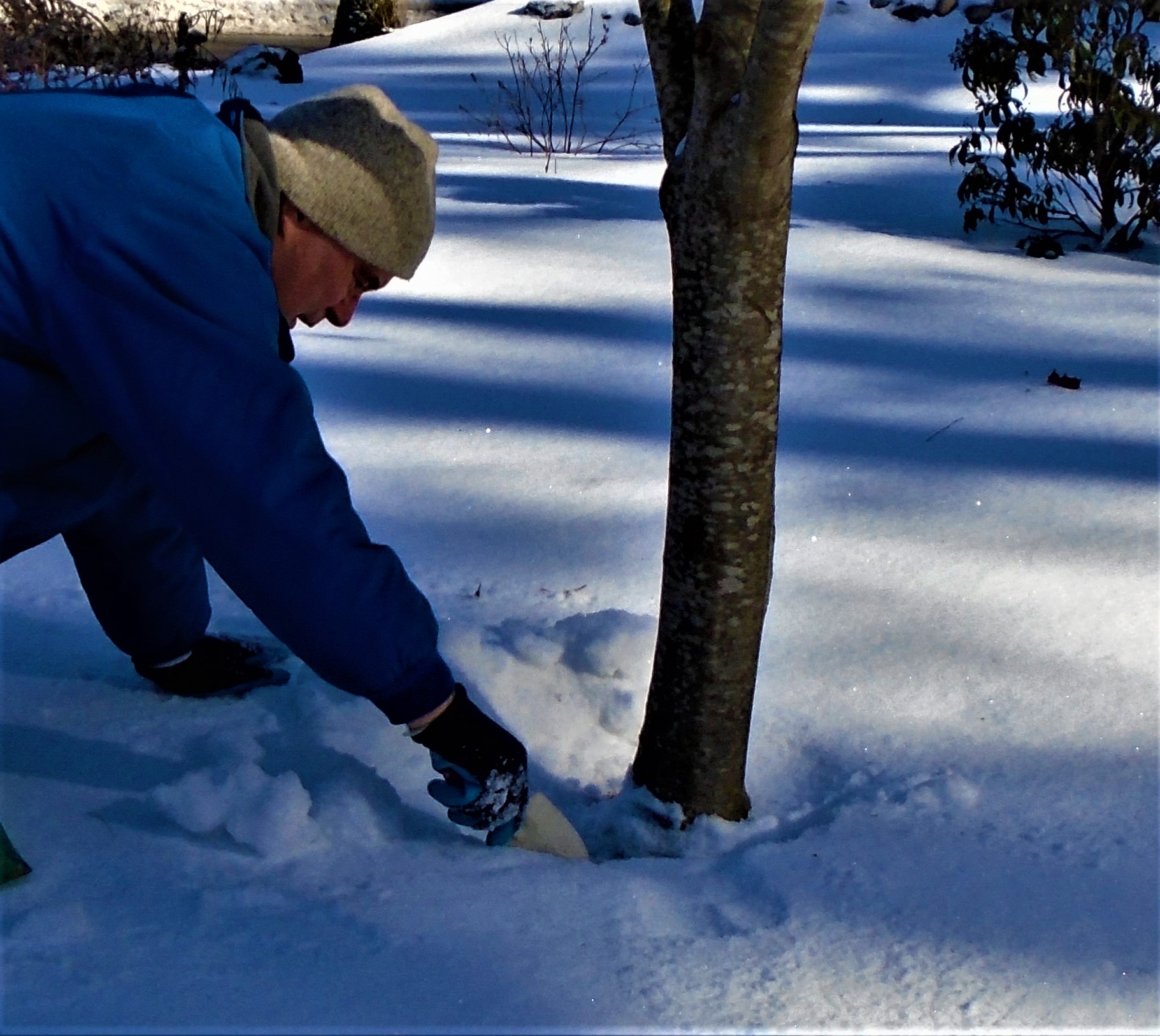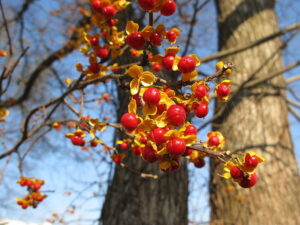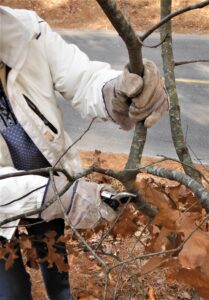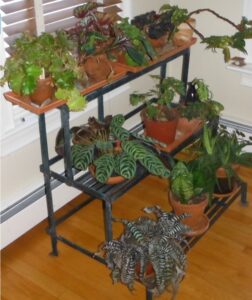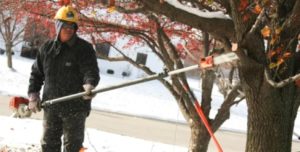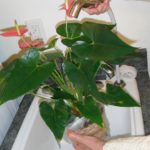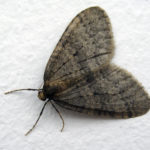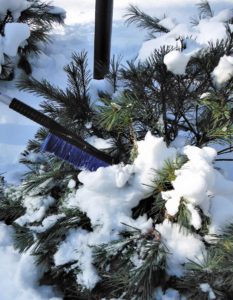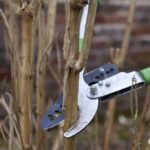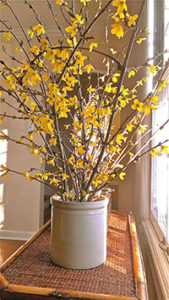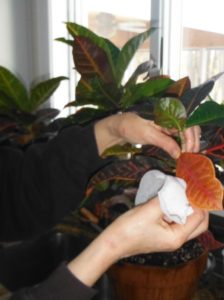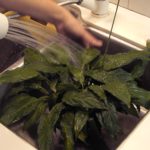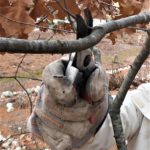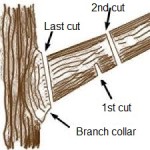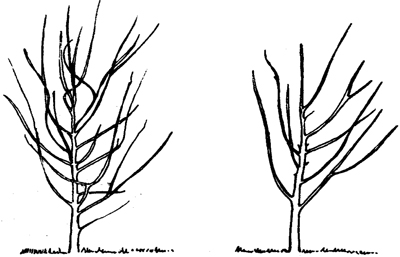Horticultural Hints – February
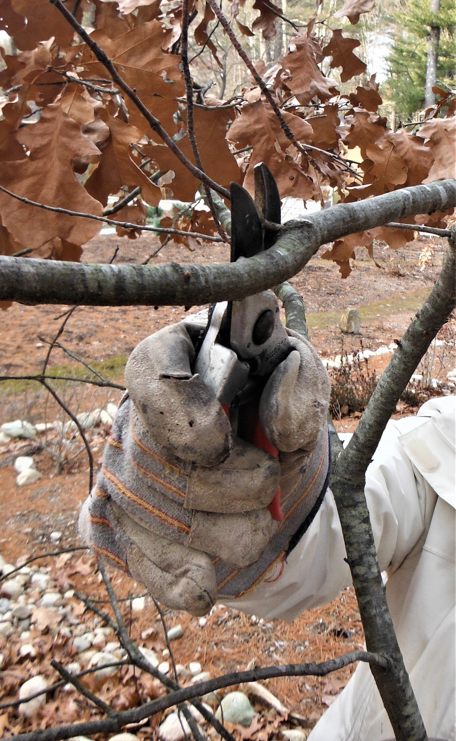 Time to prune. Now is the time to do your pruning of any plant that does NOT flower in the spring. Trees and shrubs are dormant, meaning the cold weather and short days have shut down many of their activities. (Don’t think of your plants as active? They are when they are growing leaves and new branches, setting flowers, making fruit or employing their defenses against insects and disease!)
Time to prune. Now is the time to do your pruning of any plant that does NOT flower in the spring. Trees and shrubs are dormant, meaning the cold weather and short days have shut down many of their activities. (Don’t think of your plants as active? They are when they are growing leaves and new branches, setting flowers, making fruit or employing their defenses against insects and disease!)
Pruning now allows the wounds to dry and begin the healing process before spring begins. Use common sense when pruning. Never prune above your head — think where that branch is likely to fall. Always wear heavy gloves to protect your fingers. Use only sharp tools, they will make the work faster, easier and less tiring. And never prune while standing on a ladder — that’s for professionals.
Clear snow around small trees to make it harder for rodents to eat the bark. On a warm day (about 40 degrees), spray deer repellents on the evergreens that the deer eat. As they get hungrier, deer become less fussy about what’s on the menu, but a mouthful of repellent may send them to another area.
Extra care for houseplants. Think about your houseplants from their point of view: Your home is warm but there is little humidity, and sometimes hot air blows over you. The sunlight coming through the windows is very weak in February. You may be left in the hands of plant sitters who over-water or under-water and forget to give you a quarter turn every week so you don’t start to lean into the window, where you could get frostbite.
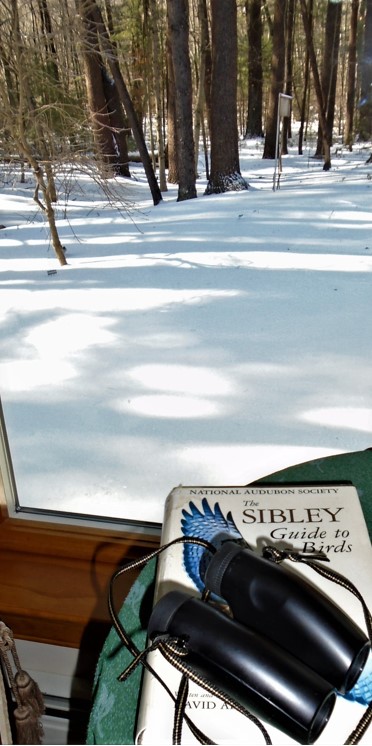 If you are responsible for the plants in your house, remember they need care, especially in winter. Give your plants a shower in the sink or tub to remove dust and grime that lands on leaves, spray them weekly or set them on pebbles with water below the pot to increase humidity in your home. Water only sparingly until growth begins again. And for plant’s sake, don’t fertilize until they have more sun (or artificial light) to make use of fertilizer.
If you are responsible for the plants in your house, remember they need care, especially in winter. Give your plants a shower in the sink or tub to remove dust and grime that lands on leaves, spray them weekly or set them on pebbles with water below the pot to increase humidity in your home. Water only sparingly until growth begins again. And for plant’s sake, don’t fertilize until they have more sun (or artificial light) to make use of fertilizer.
A good deed now will pay dividends later. Feeding birds allows you to enjoy them now from inside. And when spring arrives, it means you have encouraged them to look for dinner in your yard. Eating insects, weed seeds and adding interest to your landscape is how they will repay you this spring and summer. To further your own education on who is in your yard, purchase a bird guide book (such as Sibley’s or Audubon) and keep it handy by a window.
Cut the vines that bind. One of the advantages of winter is that certain problem areas are more readily apparent. For example, invasive vines stand out in stark relief against the trees those vines are climbing – and strangling. Use your walks around your own property and neighboring areas to spot unwanted species such as Asian bittersweet, wisteria, and English ivy. Cut them close to the ground and leave them in place to die, while periodically checking the site for growth from the vine’s roots.
A great month to prune. Another advantage of winter is the opportunity to see problem areas in your shrubs and fruit trees. Without leaves, problems such as water spouts and crossing branches are easy to spot and just as easy to cut out. Making certain you’ve recently sharpened your pruners, go after those problem areas you can easily reach from the ground. If the problem requires a ladder though, it’s time to call in a professional.
Help the birds get through the winter. Birds that choose to overwinter in New England do so because they can find sufficient food. Water, though, is harder; and even vernal pools can freeze up in February. You can do your avian friends a good turn by either purchasing and setting up an electrically heated water station, or frequently replenishing the water in your unheated bird bath placed in a sunny location.
Houseplants can dry out. Your houseplants need less water in the winter, and certainly don’t require fertilizing. But, if you have plants close to radiators, forced hot air, or other heat sources, check them frequently because those pots will dry out far more quickly than ones setting away from heat outlets. A finger pushed down into the soil is the best determinant of whether the plant’s soil is drying out too quickly.
Beware of freeze and thaw. Unlike other recent winters, there’s no snow on the ground this year to provide a protective blanket for perennials and recently-planted shrubs. As temperatures drop into the teens at night but rise into the 30s or higher during the day, the freezing and thawing cycle can push a plant out of the ground. Gently use the heel of your hand to press plants back to be flush to the soil.
 A present from the heart for gardeners. Instead of flowers on Valentine’s Day, how about a gift certificate to your loved one’s favorite nursery? Valentine’s Day flowers have often been stored to be ‘stockpiled’ for the February 14th rush and are marked up substantially. A gift certificate will be remembered in April and May, long after flowers are faded. If a nursery gift certificate isn’t appropriate, how about a membership in a horticultural, environmental, or conservation organization?
A present from the heart for gardeners. Instead of flowers on Valentine’s Day, how about a gift certificate to your loved one’s favorite nursery? Valentine’s Day flowers have often been stored to be ‘stockpiled’ for the February 14th rush and are marked up substantially. A gift certificate will be remembered in April and May, long after flowers are faded. If a nursery gift certificate isn’t appropriate, how about a membership in a horticultural, environmental, or conservation organization?
If you have trees or shrubs to remove, or other major work in the garden, get it done while the ground is frozen in order to prevent much more serious damage that will occur if it is done when the ground softens in the spring – usually by mid-March. Soft ground compacted by heavy machinery will need a major reworking to make it loose enough for plants to grow well next year. Few things are as bad for lawns or gardens as soil compaction.
 Get out and take a class! Whether it’s on vegetable gardening or orchid growing, pruning shrubs in your yard or replacing your conventional lawn with a more environmentally sound alternative, use the time you are not gardening to become a better gardener and steward of the land.
Get out and take a class! Whether it’s on vegetable gardening or orchid growing, pruning shrubs in your yard or replacing your conventional lawn with a more environmentally sound alternative, use the time you are not gardening to become a better gardener and steward of the land.
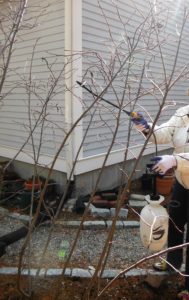
Caterpillars feasted on the leaves of this fruit tree last year. A coating of horticultural oil will smother the eggs left behind.
Take advantage of days when it is above freezing to spray dormant oil on your fruit and nut trees. Dormant – also called horticultural – oil is harmless to birds and bees. It coats and smothers egg masses of damaging insects so they will not hatch and start eating the tree’s new leaves in the spring. It must be applied on days when the temperature is above freezing and before leaves start to open, so February and March provide the best window for their use.
On a warm day, consider a trip around your yard to refresh the anti-desiccant coating on both broad leaf (like rhododendrons) and needled evergreens that can be damaged by strong sun or drying winds over the winter. (Wilt-Pruf and Wilt-Stop are two such products). While we have mostly had a mild winter so far, every New Englander knows there is no guarantee harsh weather isn’t coming.
If you are a vegetable or flower gardener who starts your own seedlings indoors for planting later, February is the month to get ageratum, petunias, and other annual flowers started along with vegetables such as beets, leeks, lettuce and onions. Your work now will give you a head start on a more productive garden this season.
While this has been a low-snowfall winter thus far, that can change quickly in February. Clear snow around small trees and shrubs to make it harder for rodents to eat the bark. On a warm day (above 40 degrees), spray deer repellents on the evergreens that the deer eat. As they get hungrier, deer become less fussy about what’s on the menu, but a mouthful of repellent may send them to another area.
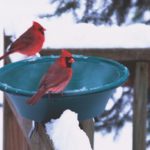
Birds can find ample food in winter, but the nicest thing you can do is ensure they have fresh water
For the birds. One of the hardest things for birds in the winter is the lack of water. While putting out seeds and suet certainly helps, a shallow container of water birds can drink from is vital. If you don’t have a heated bird bath, put out fresh water for the birds each morning in a sunny location. It may freeze during the day, but the birds in your garden will have had the chance to get a very important drink before it does.
 Winter Vortex means you wear Gore-Tex. Late January’s extreme weather was the North Pole making a visit to your garden (minus the sleigh and reindeer). You won’t know what it means for your garden until spring. If you have plants that aren’t listed as hardy for your zone, you may have damage or even lose some. The most widespread problem will probably be damage to spring flower buds that weren’t ready for the extreme chill. In the future you can consider protecting the buds by wrapping the plant in row cover and then adding a waterproof cover—like a tarp tied over. Of course, if we have an unusually warm winter, make certain you unwrap it so the buds aren’t scorched.
Winter Vortex means you wear Gore-Tex. Late January’s extreme weather was the North Pole making a visit to your garden (minus the sleigh and reindeer). You won’t know what it means for your garden until spring. If you have plants that aren’t listed as hardy for your zone, you may have damage or even lose some. The most widespread problem will probably be damage to spring flower buds that weren’t ready for the extreme chill. In the future you can consider protecting the buds by wrapping the plant in row cover and then adding a waterproof cover—like a tarp tied over. Of course, if we have an unusually warm winter, make certain you unwrap it so the buds aren’t scorched.
The weather has been frightful, but that doesn’t mean you don’t have chores this month. First, have you ordered the seeds you want for you flower or vegetable garden? Wait too long and you’ll find your first choices may be sold out. And if you are someone who starts seeds indoors, make certain you have the supplies you need now. While you are looking at the catalogs, make notes on new varieties or plants you want to try this year. Why? Sometimes we forget everything we planned when faced with a plethora of choices when you walk into a nursery brimming with seedlings.
Summer tours. Start Googling garden tours — especially the local ones. Yes, you can take tours of exotic and famous gardens around the world, but start closer to home. There are great ideas you could borrow from local garden club garden tours (and it’s easier than trying to re-create Versailles in your back yard). Homeowners love to talk about their gardens. I’ve gotten terrific leads on where to find a plant I coveted. You might also get the name of a reliable landscaper. You may also see that not every dream works out the way it was envisioned and that’s a great help too.
Show your houseplants a little love with a leaf wash, either by hand with a soft cloth or in the sink or shower after covering the exposed soil with an old plastic bag. Clean leaves are more efficient at taking in sunshine—and they look nicer too. At the end of the month start fertilizing house plants again. Regular, but very weak solutions are better for plants than occasional heavy fertilizations.
Doing more good with your saw and pruners. Now is a great time to cut down vines that are growing on trees. Even decorative vines can grow too large for the good of a tree or too heavy for a trellis to support. And if you have any invasives such as oriental bittersweet, Japanese honeysuckle or mile-a-minute vine near you, cut them down and bag them for the trash; never compost these major horticultural felons. For more information, Google ‘MA Invasive Plant list’ which includes common and scientific names. Click on the plant name to see a photo of the felon.
When it warms up and before the snow gets too deep, prune for shape, to control growth and to remove any storm-damaged limbs. You can prune grapes, most fruit trees and evergreens. Because you would be removing flower buds, don’t prune trees or shrubs that bloom in the spring unless you are doing so to remove damaged limbs.
Good news about winter moths. Did you notice there were fewer winter moths about? Researchers have been releasing of parasitic flies in several New England states. Along with the feeding of some native in-ground beetle on the winter moth pupa, the numbers are definitely down and that is great news for our oaks, maples, blueberries and many other trees and shrubs.
After the snow, gently remove snow from evergreens. A car’s snow brush or a small broom can remove the snow without risking damage to the plant. Snow covering perennials and small shrubs will help protect them from sudden temperature changes, which are more deadly to plants than the cold.
Remember the birds. It has been a dreadful winter for the birds. Continue to put out fresh seed and suet. Remember also that birds need water. Put out a shallow dish next to your feeder. While you may need to change it daily when temperatures are below freezing, it’s one of the best good deeds you can do.
Winter pruning. Now is a good time to do your winter pruning. Start with any plant that has been damaged during earlier storms. If a tree is so damaged it needs to be removed, have an arborist do the work before the ground thaws in the spring. Next tackle fruit trees, grapes and evergreens to have them done before the spring growth spurt begins. Do not prune any spring or early summer bloomers—you’ll be cutting off the flowers.
Time to cut branches to force indoors. Start with forsythia, witch hazel, and pussy willows; later look for quince and small branches from cherry trees to brighten your home.
Ice melting chemicals and road salt will soak into the ground during thaws where they will kill plants when they begin growing again in the spring. Instead of chemicals, use cat litter, sand or other non-toxic materials on sidewalks and driveways.
Resent florist Valentine’s Day prices? Give a gift certificate to your gardener’s favorite nursery and get thanked again when it’s time to buy whatever the gardener is dreaming of growing this year.
Clean up your houseplants—spray or wipe smooth leaves with a damp cloth to remove dust, use a small brush to clean fuzzy leaves such as African violets which don’t like to get wet. Clean leaves can take advantage of every bit of sunlight they get. Toward the end of the month, begin using a weak fertilizer solution for watering.
Finish ordering seed, if you haven’t already. If you chose flower or vegetable seeds that need to be started indoors, pay careful attention to how deep to plant, how much light is needed and the minimum and maximum temperatures for the seedlings. Before you start those seedlings, be realistic about the amount of attention you can devote to them until they are ready to go outdoors. Sometimes it is better to buy your garden seedlings from a reputable nursery in the spring.
Did you save dahlia or canna or gladiola bulbs? Check them now, discarding any that are decayed. And make note on the calendar of when you need to start them for summer bloom. Start tuberous begonias now.
Time to prune. Now is the time to do your pruning of any plant that does NOT flower in the spring. Trees and shrubs are dormant, meaning the cold weather and short days have shut down many of their activities. (Don’t think of your plants as active? They are when they are growing leaves and new branches, setting flowers, making fruit or employing their defenses against insects and disease!) Pruning now allows the wounds to dry and begin the healing process before spring begins. Use caution when pruning. Never prune above your head — think where that branch is likely to fall. Always wear heavy gloves to protect your fingers. Use only sharp tools, they will make the work faster, easier and less tiring. And never prune off a ladder — that’s a job for professionals.
Extra care for houseplants. This is your lot in life: you have a home and it is warm, but it is also very dry and sometimes hot air blows over you incessantly. The sunlight coming through the windows is weak. You may be left in the hands of semi-competent neighbors who over-water or under-water and forget to give you a quarter turn every week so you don’t start to lean into the window, where you could get frostbite. You can’t remember the last time you felt the joy of a rain shower. You are a houseplant.
If you are responsible for the plants in your house, remember they need care even when they aren’t growing much. Give your plants a shower in the sink or tub to remove dust and grime that lands on leaves, spray them weekly or set them on pebbles with water below the pot to increase humidity in your home. Water only sparingly until growth begins again. And for your plant’s sake, don’t fertilize until they have more sun (or artificial light) to make use of fertilizer.
Finally, do you have one or more special plants you would love to share with the world? Start giving it some extra grooming. And circle your calendar for the first day of Spring — March 20, which is also entry day for plants at the Boston Flower and Garden Show. The people there will help you make any last minute touches and help you find the tricky Latin name. And there’s nothing like a shiny ribbon to dress up your plants
If there’s ever snow. Eastern Massachusetts has had little snow this year, but Mother Nature usually saves her biggest surprises for February. If the snow gets deep, clear it carefully off bent branches. When a big storm is predicted, try to clean the branches as the snow builds up and before it is too deep, or the branches are too heavily laden. Don’t whack the branches with a shovel but gently lift the branches from below with a broom.
Also clear snow around small trees to make it harder for rodents to eat the bark. On a warm day (above 40 degrees), spray deer repellents on the evergreens that the deer eat. As they get hungrier, deer become less fussy about what’s on the menu, but a mouthful of repellent may send them to another area.
It’s time to start pruning. Okay, your property is under two feet of snow. That’s the bad news. The good news is that the trees and shrubs are dormant: you can work on them without setting off an unwanted growth spurt on the plant’s part. That makes February the perfect time to begin your winter pruning. Here’s what to do.
First, never prune anything you can’t reach from the ground. Leave that work for professionals.
Second use high quality tools. They may cost more to purchase, but they will last a lifetime if properly cared for. And because they are well designed, they will save you a lot of work along the way. Any cutting tool — pruners and loppers — that were not cleaned, oiled and sharpened before being putting away in the fall, need to be readied before you head outside to work. A good chore for snow days!
And a reminder, except where there is damaged or dead wood to be removed, now is not the time to prune spring-blooming trees and shrubs. Doing so will result in cutting off the buds that formed last summer.
Basic tree pruning’s first rule is Do No Harm. Bad pruning can do more damage than no pruning at all. When in doubt, call in a professional. Clean, sharp tools properly used will leave healthy wood. Re-sharpen pruners as you work and clean tools between cuts or at the very least as you move from one tree to another. Every pruning cut should be at the branch collar—not flush with the trunk and never leaving a stump.
For young, deciduous trees, concentrate on establishing a sturdy framework for later growth. For most trees, this means pruning out all but one strong leader (the center stem) and creating a ladder of sturdy side branches (laterals) that will help determine the shape of the tree as it grows.
For mature deciduous trees, first remove all dead, damaged, diseased or dying wood. If you are not certain a branch is dying, leave it until spring when the quantity and quality of new growth will help you determine its viability.
Stage two is to remove unnecessary growth (such as sprouts) and badly placed or congested stems. A good example of something to remove are crossed branches that are currently or will soon rub against each other. The damage that results from rubbing opens the tree to diseases and insects.
Weak branch crotches – where a V-shaped angle exists between two branches – is never as strong as a more horizontal angle. Correct this by removing the branch that is not providing sufficient outward growth. Branches growing into the tree will soon be crossing others.
Thin out any areas of dense heavy growth. Wind and birds should be able to go easily through your tree. Pause frequently to look at the tree. Pruning too little is easily corrected. Pruning too much is not. If in doubt, wait for another day to do more pruning.
You must know about the growth habits of your conifers before pruning. Many, especially pines, have only a single growth spurt each year. These and broad leaved evergreens are usually pruned in late spring after the new growth has appeared. Some conifers such as yews grow continually throughout the spring and summer and that must be considered when planning to prune. To shorten or control growth on a conifer, cut a branch where it forks into side branches and one of these will dominate, maintaining the shape of the tree. Cut it between side branches and you will be left with an ugly stump that will never produce foliage again.
Earlier Years Hints
Getting ready for spring. Yes, the forecast is for more snow and more cold, but now is the time to plan, if not plant. If you haven’t ordered your seeds yet, pull out the catalogs or go online and do so. The new, the unique, the old favorite seldom are available on the seed racks in stores. It’s also time to pull out the books and saved magazine articles and begin making plans for your vegetable garden, a redesign of your yard or just the new plants you want to fill in your beds. One day you will look out quite astonished to find that spring has arrived. Be ready when that happens.
Classes and clubs. Many organizations offer classes during the late winter and early spring to help you get the latest information on plants, insects, diseases, replanting or redesigning your garden. Look around and sign up for those that meet your needs. Also, if you’re not already a member of one, consider joining a garden club; most of which offer lectures or workshops at monthly meetings as part of dues. You will be with others who love to garden and learn from folks who will become friends.
Pruning. February is the time to begin pruning anything that does not bloom in the spring. (If you prune spring bloomers now, you are removing flowers.) Bare branches reveal a tree or shrub’s true form, making decisions about removing excess growth easierAlways keep the natural shape in mind. Trying to force a tree into a shape that is not natural to it is bad for the tree and a continuing load of work for you.
Cutting back water sprouts is an important and easy task. Damage, bad pruning or genetics can lead a tree to produce these useless branches. They are very easy to spot now since they are almost always vertical, reaching for the sun and lacking side branches. Cut them off now and your tree or shrub will be off to a better start this spring.
Before you begin cutting, sharpen your pruners and loppers. It is a much harder job with dull blades. And, leave anything you can’t reach from the ground to the professionals —ladders, sharp tools and power equipment do not mix!
If you had storm damage this winter, a mild day is the perfect time to go out, gather the downed branches and get them ready to be chipped or carted off to the municipal compost pile. There may be more storms, but anything you do now saves you time when spring arrives
Valentine’s Day. In my opinion, February 14th is the worst day to get fresh flowers. I love Valentine’s Day (it’s the day I was married), but cut flowers have been mistreated in every possible way to have a large supply ready on the one day. They are overpriced because of demand and seldom at their best. For many years now, I have received pots of forced bulbs a week or more before the big day, or a gift certificate from a favorite nursery, taped to a long stick and placed in my favorite vase. In my house these are signs of love and a promise that spring is not so very far away.
Your garden journal. Don’t forget to include weather, especially the unseasonably warm or unbearably cold, the amount and type of precipitation and whatever you spy as you look or walk about your garden. What birds are feeding in your garden? Have any buds begun to swell on your plants?
Earlier years’ hints: February 2013
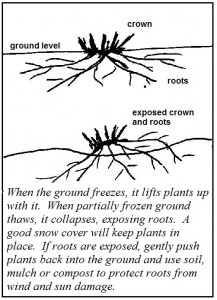 Freeze and Thaw Is Bad for Plants. Well below zero, then temperatures pushing 60, then more freezing — these are extreme conditions and exactly what we saw at the end of January. Check your perennials and any newly planted trees or shrubs to be certain they have not been partially pushed out of the ground. When the ground freezes, it lifts plants up with it. When frozen ground thaws, it collapses as the ice crystals melt, no longer supporting the soil. Plant crowns and roots can be exposed to the sun and drying winds. Gently push the plant back in the ground and use soil, mulch or compost to cover and protect the roots from additional damage. Among perennials, the most susceptible ones to this problem include heuchera, coreopsis, chrysanthemum, and Shasta daisy.
Freeze and Thaw Is Bad for Plants. Well below zero, then temperatures pushing 60, then more freezing — these are extreme conditions and exactly what we saw at the end of January. Check your perennials and any newly planted trees or shrubs to be certain they have not been partially pushed out of the ground. When the ground freezes, it lifts plants up with it. When frozen ground thaws, it collapses as the ice crystals melt, no longer supporting the soil. Plant crowns and roots can be exposed to the sun and drying winds. Gently push the plant back in the ground and use soil, mulch or compost to cover and protect the roots from additional damage. Among perennials, the most susceptible ones to this problem include heuchera, coreopsis, chrysanthemum, and Shasta daisy.
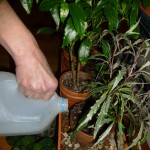
Filling a tray with pebbles and adding water gives houseplants the humidity help they need in winter.
Houseplant Care. Most houseplants are resting now but they shouldn’t be ignored. The tropicals we grow in our homes are suffering in the dry air. Last week’s extreme cold made our furnaces work overtime, drying out the air even more. One easy way to provide moisture without risking overwatering is to place a double layer of pebbles in the bottom of the plant saucer and add water just below the bottom of the pot. As the water evaporates, it gives plant leaves the moisture they need without the risk of overwatering. Keeping plants together also allows each one to benefit from others’ humidity.
This may sound silly, but don’t forget to wash or dust your houseplants. Those that don’t mind getting their leaves wet should take a trip to the sink or tubs where they can be gently sprayed off with warm water. For any too large to lift, wipe each leaf clean with a rag and warm water For African violets and other plants that do not like water on their leaves and those who should not be watered in the winter (cacti and most succulents, for example), use a soft paint brush to gently clean the dust from the leaves. Your plants will look better to you and appreciate the extra light that will reach them.
Indoor Spring. Any tulips or other bulbs in storage for forcing should be ready to begin growing now. If you have leftover paperwhites, they will grow and flower very quickly if placed in wet pebbles at this time of year.
If you need a dose of spring bigger than a pot, visit some of the wonderful local greenhouses. The camellias have started to bloom at the Lyman Estate Greenhouses where the orchids and bougainvillea and a host of other tropicals will delight. The Margaret C. Ferguson greenhouse at Wellesley College is open to the public and offer tours so you can put a name with that wonderful flower you just saw. And we cannot make it through a winter without visiting the wonderful Orangerie and Limonaia, greenhouses like you never imagined them, at Tower Hill Botanic Garden in West Bolyston.
Pruning. Once the coldest days of winter have passed, probably the end of February, you can begin pruning any plant that does not bloom in early spring. Pruning your spring blooming hydrangea or lilac or any other early bloomer will mean no flowers this spring. Confine your work to evergreens, summer and fall blooming shrubs and trees that need structural pruning. Remember if you can’t do the work with your feet on the ground, you should call in a professional.
Starting from seed. Get your seed orders in now. Whether you will be growing vegetables, annuals or perennials – or all of them – from seed, you will get the best selection and the fastest delivery if you order soon. [Check the article in this issue on making the seed catalog into a helpful partner and in choosing what you will grow this year.]
Hints from earlier years:
February 2012 Hints
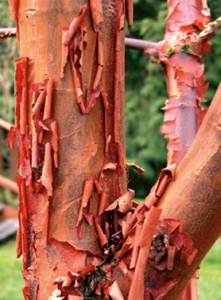 Enjoy a walk around your winter garden. You’ll find a different place than in the summer. Beautiful barks take center stage when you can see the colors of red twig dogwood and kerria and the ornamental patterns created by the peeling barks of stewartia (at right), acer grissom (paperbark maple, seen at left)) and of course, birches. Some years we miss the flowers of cornus mas (witch hazel) and hellebores because we can’t get out to see them. This year they should be the highlight of your winter garden. But be careful where your tread: footprints left in mud will still be there in the spring and walking on frozen lawns can cause damage.)
Enjoy a walk around your winter garden. You’ll find a different place than in the summer. Beautiful barks take center stage when you can see the colors of red twig dogwood and kerria and the ornamental patterns created by the peeling barks of stewartia (at right), acer grissom (paperbark maple, seen at left)) and of course, birches. Some years we miss the flowers of cornus mas (witch hazel) and hellebores because we can’t get out to see them. This year they should be the highlight of your winter garden. But be careful where your tread: footprints left in mud will still be there in the spring and walking on frozen lawns can cause damage.)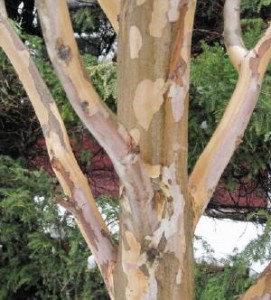
Pruning time. Since we still don’t have any snow cover, there’s no excuse not to get out and do your winter pruning. Prune for shape, to control growth and to remove any storm-damaged limbs. You can prune grapes, most fruit trees and evergreens. Because you will also removing flower buds, don’t prune trees or shrubs that bloom in the spring unless you are doing so to remove damage. Now is also a great opportunity to cut down vines that are growing on trees. Even decorative vines can grow too large and too heavy for the tree to support. And if you have Massachusetts designated invasives such as oriental bittersweet, Japanese honeysuckle or mile-a-minute vine, cut them down, dig them out and send them to the dump—never try to compost these horticultural felons.
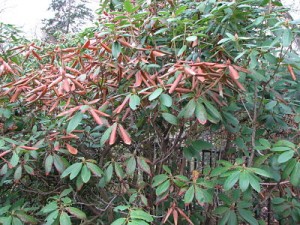 Spray as needed. The deer may have access to more food than most winters, but that will not stop them from feasting on your plants’ flower buds, leaves and twigs. Most repellent sprays need to be applied monthly to be effective. You can also protect broadleaf and other evergreens with an anti-dessicant on days when the temperature is above 45 degrees. While curled rhododendron leaves are nature’s indicator of sub-freezing temperatures, don’t wait for spring to find out that sunshine and drying winds have left you with damaged leaves and dried out flower buds, like the rhododendron leaves shown at right.
Spray as needed. The deer may have access to more food than most winters, but that will not stop them from feasting on your plants’ flower buds, leaves and twigs. Most repellent sprays need to be applied monthly to be effective. You can also protect broadleaf and other evergreens with an anti-dessicant on days when the temperature is above 45 degrees. While curled rhododendron leaves are nature’s indicator of sub-freezing temperatures, don’t wait for spring to find out that sunshine and drying winds have left you with damaged leaves and dried out flower buds, like the rhododendron leaves shown at right.
Curl up with a catalog. While it’s too early to start seeds indoors for vegetables, it’s the perfect time to start ordering from the catalogs. Take time to read the descriptions—are you looking for a super-sized crop (Mortgage Lifter) or a variety known for flavor? Will you grow heirloom varieties or are you more comfortable with hybrids bred to resist disease? The right answer will depend on how much time you have to devote to your garden next spring and summer, as well as what you are looking for from your garden. There are no wrong choices – except not to plant vegetables at all.
Indoor plant care. As long as your plants aren’t drooping, they are not suffering under your winter low water regimen. As the day get longer, you may need to increase the amount of water, but always check first. Do not start fertilizing again until March. Keep the humidity up around your plants by misting, using pebble trays and individual showers to help prevent plant lice and scale.
February 2011
Cut Branches for Forcing. Your garden won’t bloom in February (except perhaps witch hazel and Cornus mas) but you can enjoy spring blooms now by cutting branches to force. Choose from those plants that bloom early—forsythia, crabapple, quince and plums are all good candidates. Go out to cut midday, when sap has risen, not early in the morning as you would to cut flowers. Look for swollen buds on the branches. Now look at the tree or shrub as a whole and remember that as your cut you are also pruning. Take the cut branch inside and recut on an angle, place it in warm water as high up the branch as possible. After a few hours, cut the stem on an angle again and place in a vase of cool water. Blooms will last longest if kept in a cool room (under 65 degrees) and out of direct sunlight.
Winter Pruning and Clean-up. The storms we are all tired of have not only blanketed our area, but have also damaged more than a few trees and shrubs. While our perennials are protected from the cold by their blanket of snow, our woody plants need help. Begin your clean-up pruning as soon as you can safely work outdoors. Keep in mind that clean cuts heal faster, and with less chance of damage from disease or insects, than ragged tears.
Trees and shrubs bent over from the weight of snow and ice should not be assumed to be permanently damaged. Many trees that are currently bent to the ground may surprise you with their ability to straighten when the weather warms and the sap rises within them. While the snow may not be deep in areas along the coast or on the Cape, in other places it has completely buried small, and not so small, shrubs. Do not try to dig the plant out. The chance of doing more damage with a shovel than is done by the snow is too great.
Houseplants = Show Plants. With Blooms! at the Boston Flower & Garden Show only a little over a month away, start preparing your best houseplants to be entered in the amateur horticulture division. No pre-entry is required for most plants, but you need to get busy now. Read the Amateur Horticulture rules completely so you know what is required.
Begin grooming your plants by carefully cutting any dead or damaged leaves as close to a healthy main stem or the soil level as possible. Old flower stems should be removed. Gently clean leaves with a wet cloth to remove any water or fertilizer spots. Leaf shine and other such products cannot be used on flower show entries. Your pot should be cleaned of dirt and salt stains. And remember that the container is there to hold the plant, not be an attraction or distraction from it. Continue caring for your plant, increasing your attention to grooming as March 14 approaches. No plant with any signs of disease or insects should ever be taken to a flower show.
On entry day, pack your plant carefully in a cardboard box, cushioned to protect it from sliding about as your drive to the show. Make certain your vehicle is warm before you put the plant inside and keep it covered until you are inside the Seaport World Trade Center. Entry day is March 14 from noon to 8 p.m. There’s a convenient loop road that will take you around the building to a drop-off area that ensures your plants are never exposed to the elements.
* * * * *
It’s February and, if you live in most parts of eastern Massachusetts, your garden is buried under eighteen inches of snow. Unlike last year – a sparse year for snow – the winter of 2008-2009 is shaping up both as a wet and cold one. The good news is that the blanket of snow over your perennials will help them to better weather the freeze-thaw cycle. The downside is that extreme cold may damage buds on flowering trees and shrubs.
But winter is also the start of the new season. Here are some things to do during the month of February both inside and outside of the home:
Be sharp. First if you haven’t already cleaned up and prepared your gardening tools for the spring, do it now. It’s quick and easy to get a lawn mower tune-up in February, much tougher in April. Metal tools should be cleaned and oiled to prevent rust. Pruners, loppers and saws all can be sharpened now for spring pruning.
Prune now. And speaking of spring pruning, winter thaws (we’re bound to have one eventually) are one of the best times to prune. First remove any wood with obvious damage from winter storms. Next take on non-blooming trees that need to be pruned. The trees are still dormant and there will be very little sap loss. For blooming trees and shrubs, prune only those that will bloom on new wood. Generally, ‘new wood’ means those trees and shrubs that bloom in late summer. Pruning spring bloomers now means you are cutting off your flowers. Plants such as dogwoods, lilacs, rhododendrons should be pruned immediately after blooming, before they set new buds.
Undo salt damage. While you are outside, check plants that may have been exposed to road (or sidewalk) salt. Be certain to give them a good bath with fresh water before they break dormancy. And if there is mulch underneath, remove the mulch before the salt leaches into the root zone.
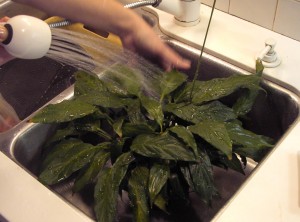 TLC for houseplants. Indoors, the days are getting longer and your plants are about to begin growing again. Give houseplants a leaf wash either by hand with a soft cloth or in the sink or shower. To keep the mess to a minimum, cover exposed soil with an old plastic bag cut open and placed around the plant.
TLC for houseplants. Indoors, the days are getting longer and your plants are about to begin growing again. Give houseplants a leaf wash either by hand with a soft cloth or in the sink or shower. To keep the mess to a minimum, cover exposed soil with an old plastic bag cut open and placed around the plant.
Start fertilizing. As we get to the end of February, it is time to start fertilizing house plants again. Remember that regular, weak solutions are better for plants than occasional heavy fertilizations.
Our January thaw brought us rain and warm temperatures last week, but with temperatures plummeting again, bundle up and check your garden. All that rain melted their snow cover and, without that snow to blanket them, perennials and some small shrubs could have been pushed out of the ground. If the soil isn’t frozen, try pushing the plants gently back into place so roots won’t freeze. If that isn’t possible, use mulch, compost or even piles of leaves to cover the roots and provide some protection. As early as possible in the spring, replant them properly.
Keep pruning. Bare branches reveal a tree or shrub’s true form and make decisions about removing excess growth easier. Grapes, blueberries and most fruit trees should be pruned now. Check gardening books or dependable web sites for details such as leaving second year spurs for fruiting on apple trees. Unless you are willing to sacrifice May’s flowers, leave spring bloomers until after blooms are finished, and wait for leaves to appear before pruning maples and birches.
Use bad weather as an opportunity to finish ordering from seed and plant catalogs. Ordering now means you get the widest choice of seeds and plants, and ensures you’ll be ready to start seedlings for spring planting. Some seeds need to be started now to in order to be ready to transplant when the soil is warm enough. You can safely order bare root trees and tender plants now. The nurseries will ship them at the right time.
More bad weather? Read those gardening magazines and books that have piled up while you were busy with the holidays. Lay out your vegetable garden on paper (don’t forget to order seed to replant areas as spring crops finish in early summer.) Sketch your property plan and decide if there are areas you want or need to renovate.
Houseplants may need some extra attention now. Dry air in our houses encourage predators such as mealybugs and aphids. Mist plants or use pebble trays to increase humidity. Wash leaves to remove dust. Prune out any dead or yellowing leaves. Because days are longer now, you can start repotting houseplants. And begin fertilizing houseplants again later this month.
Finally, give the gardener in your life a Valentine gift certificate to a favorite nursery or a longed-for garden tool instead of a bouquet of flowers or a box of chocolates.
